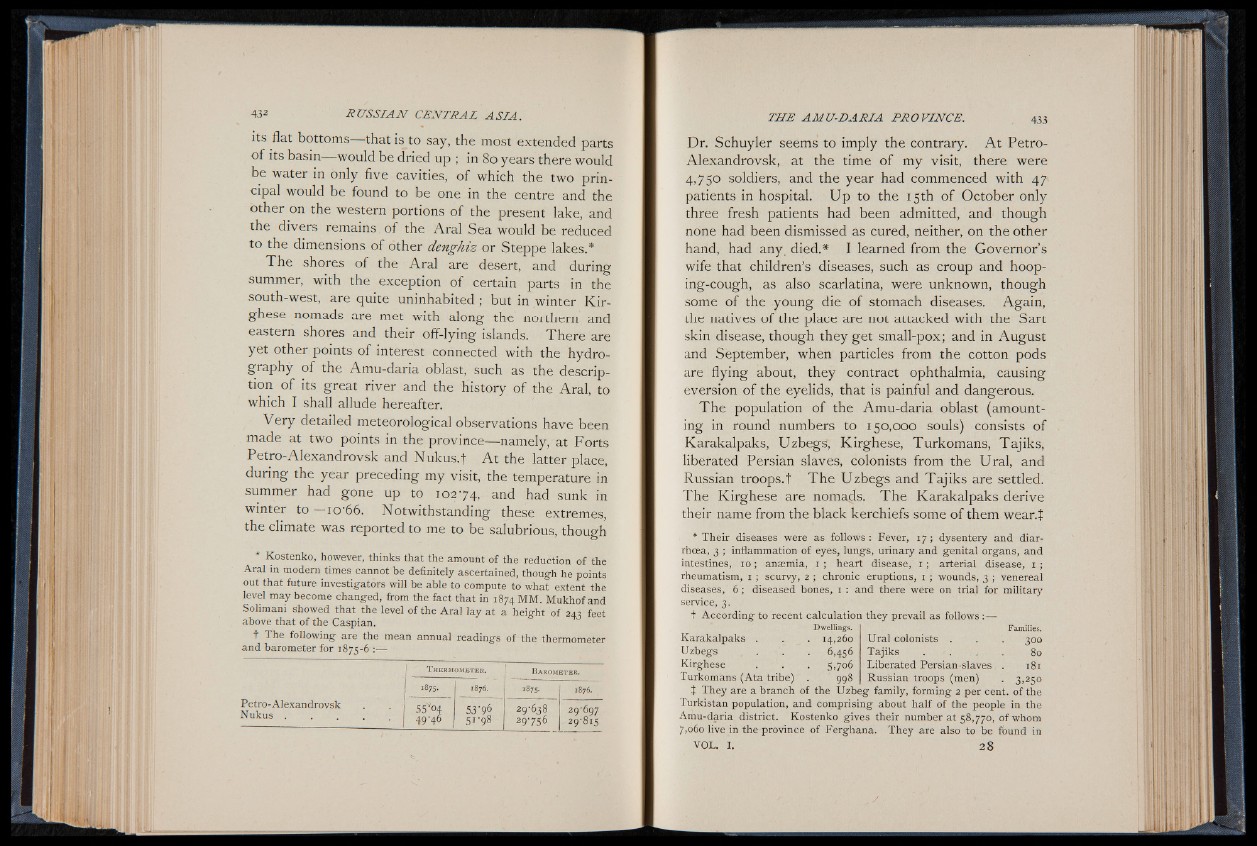
its flat bottoms that is to say, the most extended parts
o f its basin— would be dried up ; in 80 years there would
be water in only five cavities, of which the two principal
would be found to be one in the centre and the
other on the western portions of the present lake, and
the divers remains of the Aral Sea would be reduced
to the dimensions of other denghiz or Steppe lakes.*
The shores of the Aral are desert, and during
summer, with the exception of certain parts in the
south-west, are quite uninhabited ; but in winter Kir-
ghese nomads are met with along the northern and
eastern shores and their off-lying islands. There are
yet other points of interest connected with the hydrography
of the Amu-daria oblast, such as the description
of its great river and the history of the Aral, to
which I shall allude hereafter.
Very detailed meteorological observations have been
made at two points in the province— namely, at Forts
Petro-Alexandrovsk and Nukus.t A t the latter place,
during the year preceding my visit, the temperature in
summer had gone up to 10274, and had sunk in
winter to —io -66. Notwithstanding these extremes,
the climate was reported to me to be salubrious, though
* Kostenko, however, thinks that the amount of the reduction of the
Aral in modem times cannot be definitely ascertained, though he points
out that future investigators will be able to compute to what extent the
level may become changed, from the fact that in 1874 MM. Mukhof and
Solimani showed that the level of the Aral lay at a height of 243 feet
above that of the Caspian.
t The following are the mean annual readings of the thermometer
and barometer for 1875-6
T h e r m o m e t e r . B a r o m e t e r .
1 8 7 5 , X876. i S 7 S . l 8 7 6 .
Petro-Alexandrovsk
Nukus . . . . . 55'°4
49-46
53 '96
51 '98
29-638
29-756
29-697
29-815
Dr. Schuyler seems to imply the contrary. A t Petro-
Alexandrovsk, at the time of my visit, there were
4,750 soldiers, and the year had commenced with 47
patients in hospital. Up to the 15th of October only
three fresh patients had been admitted, and though
none had been dismissed as cured, neither, on the other
hand, had any. died.* I learned from the Governor’s
wife that children’s diseases, such as croup and hooping
cough, as also scarlatina, were unknown, though
some of the young die of stomach diseases. Again,
the natives of the place are not attacked with the Sart
skin disease, though they get small-pox; and in August
and September, when particles from the cotton pods
are flying about, they contract ophthalmia, causing
eversion of the eyelids, that is painful and dangerous.
The population of the Amu-daria oblast (amounting
in round numbers to 150,000 souls) consists of
Karakalpaks, Uzbegs; Kirghese, Turkomans, Tajiks,
liberated Persian slaves, colonists from the Ural, and
Russian troops.t The Uzbegs and Tajiks are settled.
The Kirghese are nomads. The Karakalpaks derive
their name from the black kerchiefs some of them wear.î
* Their diseases were as follows : Fever, 17 ; dysentery and diarrhoea,
3 ; inflammation of eyes, lungs, urinary and genital organs, and
intestines, 10 ; anaemia, 1 ; heart disease, 1 ; arterial disease, 1 ;
rheumatism, 1 ; scurvy, 2 ; chronic eruptions, 1 ; wounds, 3 ; venereal
diseases, 6 ; diseased bones, 1 : and there were on trial for military
service, jt
According to recent calculation they prevail as follows :
Dwellings.
Karakalpaks . . . 14,260
Uzbegs . . 6,456
Kirghese . . . 5,706
Turkomans (Ata tribe)
Families.
Ural colonists . . . 300
Tajiks . , . 80
Liberated Persian-slaves . 181
Russian troops (men) . 3,250
t They are a branch of the Uzbeg family, forming 2 per cent, of the
Turkistan population, and comprising about half of the people in the
Amu-daria district. Kostenko gives their number at 58,770, of whom
7,060 live in the province of Ferghana. They are also to be fbund in
VOL. I. 28